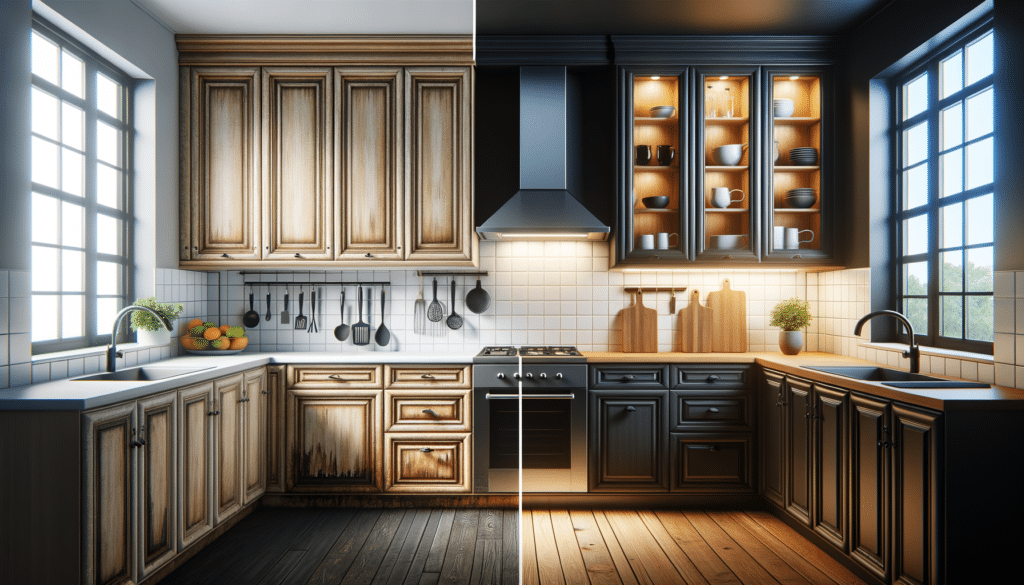Understanding Cabinet Refacing
Cabinet refacing is an innovative approach to kitchen remodeling that involves updating the exterior surfaces of existing cabinets without the need for a full replacement. This process typically includes replacing doors and drawer fronts, applying a new veneer to all exposed parts, and installing new hardware such as handles and hinges. Refacing is an attractive option for homeowners looking to refresh their kitchen’s appearance without the high costs and lengthy timelines associated with a complete overhaul.
One of the primary advantages of cabinet refacing is its cost-effectiveness. On average, refacing costs about 30% to 50% less than a full cabinet replacement. This makes it an appealing choice for those working within a budget yet desiring a fresh, modern look. Additionally, refacing is a more sustainable option as it minimizes waste by reusing existing cabinet structures.
Refacing also offers a quicker turnaround time, often taking just a few days to complete. This is particularly beneficial for those who cannot afford the disruption of a long renovation process. By choosing refacing, homeowners can enjoy a transformed kitchen with minimal inconvenience.
Comparing Refacing and Replacing
When deciding between refacing and replacing cabinets, several factors must be considered. While refacing is generally more affordable, replacing cabinets might be necessary if the existing structures are damaged or poorly constructed. However, if the cabinets are in good condition, refacing can achieve a similar aesthetic transformation at a fraction of the cost.
Refacing allows for a wide range of customization options, including different materials and finishes, which can match current design trends or personal preferences. On the other hand, replacing cabinets provides the opportunity to completely redesign the layout of the kitchen, which might be desirable for those looking to improve functionality or increase storage space.
In summary, the choice between refacing and replacing depends on the specific needs and goals of the homeowner. Those seeking a budget-friendly and less invasive update might find refacing to be the ideal solution, while others with more extensive remodeling goals might opt for a complete replacement.
Materials and Styles in Cabinet Refacing
Cabinet refacing offers a variety of materials and styles to suit different tastes and kitchen designs. Common materials include wood veneers, laminates, and rigid thermofoils (RTF). Each material has its own set of benefits and aesthetic appeal.
Wood veneers are popular for their natural beauty and ability to be stained in various shades. Laminates, on the other hand, are known for their durability and ease of maintenance. They are available in a wide range of colors and patterns, making them a versatile choice for many homeowners. RTF is a durable and cost-effective option that mimics the look of wood or painted finishes.
Style options are equally diverse, ranging from traditional to contemporary designs. Homeowners can choose from a variety of door styles, including shaker, raised panel, and flat panel, to create a look that complements their kitchen’s overall aesthetic. The choice of hardware also plays a significant role in defining the style, with options ranging from sleek modern handles to ornate traditional knobs.
Environmental Benefits of Cabinet Refacing
Cabinet refacing is not only cost-effective but also environmentally friendly. By reusing the existing cabinet structures, refacing significantly reduces the amount of waste generated during a kitchen remodel. This is an important consideration for environmentally conscious homeowners looking to minimize their ecological footprint.
Refacing also reduces the demand for new raw materials, which can help conserve natural resources. The process typically involves less energy consumption compared to manufacturing and installing new cabinets, further contributing to its eco-friendly credentials.
Moreover, many refacing materials, such as certain laminates and veneers, are made from sustainable sources or recycled materials. This adds another layer of environmental responsibility to the refacing process, making it an appealing choice for those committed to sustainable living.
Steps to a Successful Cabinet Refacing Project
Embarking on a cabinet refacing project requires careful planning and consideration to ensure a successful outcome. The first step is to assess the condition of the existing cabinets to determine if refacing is a viable option. If the cabinets are structurally sound, the next step is to choose the materials and styles that best suit the homeowner’s taste and the kitchen’s design.
It’s important to hire a reputable contractor with experience in cabinet refacing to ensure quality workmanship. A professional can provide valuable guidance on material selection and design options, as well as ensure that the project is completed efficiently and to a high standard.
Finally, setting a realistic budget and timeline is crucial. While refacing is generally more affordable than replacement, costs can vary based on the materials and finishes chosen. Homeowners should also account for any additional expenses, such as new hardware or minor repairs.
By following these steps, homeowners can achieve a beautifully updated kitchen that meets their aesthetic and functional needs without the stress and cost of a full renovation.





